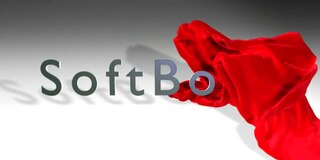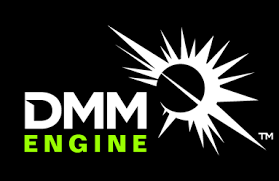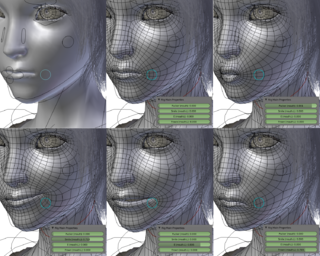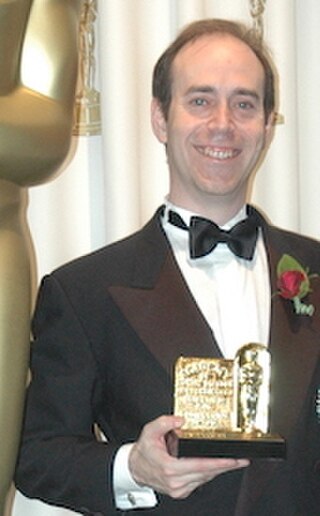Related Research Articles

Rendering or image synthesis is the process of generating a photorealistic or non-photorealistic image from a 2D or 3D model by means of a computer program. The resulting image is referred to as the render. Multiple models can be defined in a scene file containing objects in a strictly defined language or data structure. The scene file contains geometry, viewpoint, texture, lighting, and shading information describing the virtual scene. The data contained in the scene file is then passed to a rendering program to be processed and output to a digital image or raster graphics image file. The term "rendering" is analogous to the concept of an artist's impression of a scene. The term "rendering" is also used to describe the process of calculating effects in a video editing program to produce the final video output.
Autodesk 3ds Max, formerly 3D Studio and 3D Studio Max, is a professional 3D computer graphics program for making 3D animations, models, games and images. It is developed and produced by Autodesk Media and Entertainment. It has modeling capabilities and a flexible plugin architecture and must be used on the Microsoft Windows platform. It is frequently used by video game developers, many TV commercial studios, and architectural visualization studios. It is also used for movie effects and movie pre-visualization. 3ds Max features shaders, dynamic simulation, particle systems, radiosity, normal map creation and rendering, global illumination, a customizable user interface, and its own scripting language.

A particle system is a technique in game physics, motion graphics, and computer graphics that uses many minute sprites, 3D models, or other graphic objects to simulate certain kinds of "fuzzy" phenomena, which are otherwise very hard to reproduce with conventional rendering techniques – usually highly chaotic systems, natural phenomena, or processes caused by chemical reactions.

Skeletal animation or rigging is a technique in computer animation in which a character is represented in two parts: a surface representation used to draw the character and a hierarchical set of interconnected parts, a virtual armature used to animate the mesh. While this technique is often used to animate humans and other organic figures, it only serves to make the animation process more intuitive, and the same technique can be used to control the deformation of any object—such as a door, a spoon, a building, or a galaxy. When the animated object is more general than, for example, a humanoid character, the set of "bones" may not be hierarchical or interconnected, but simply represent a higher-level description of the motion of the part of mesh it is influencing.
In the field of 3D computer graphics, a subdivision surface is a curved surface represented by the specification of a coarser polygon mesh and produced by a recursive algorithmic method. The curved surface, the underlying inner mesh, can be calculated from the coarse mesh, known as the control cage or outer mesh, as the functional limit of an iterative process of subdividing each polygonal face into smaller faces that better approximate the final underlying curved surface. Less commonly, a simple algorithm is used to add geometry to a mesh by subdividing the faces into smaller ones without changing the overall shape or volume.

The Catmull–Clark algorithm is a technique used in 3D computer graphics to create curved surfaces by using subdivision surface modeling. It was devised by Edwin Catmull and Jim Clark in 1978 as a generalization of bi-cubic uniform B-spline surfaces to arbitrary topology.

Geometry processing, or mesh processing, is an area of research that uses concepts from applied mathematics, computer science and engineering to design efficient algorithms for the acquisition, reconstruction, analysis, manipulation, simulation and transmission of complex 3D models. As the name implies, many of the concepts, data structures, and algorithms are directly analogous to signal processing and image processing. For example, where image smoothing might convolve an intensity signal with a blur kernel formed using the Laplace operator, geometric smoothing might be achieved by convolving a surface geometry with a blur kernel formed using the Laplace-Beltrami operator.

Soft-body dynamics is a field of computer graphics that focuses on visually realistic physical simulations of the motion and properties of deformable objects. The applications are mostly in video games and films. Unlike in simulation of rigid bodies, the shape of soft bodies can change, meaning that the relative distance of two points on the object is not fixed. While the relative distances of points are not fixed, the body is expected to retain its shape to some degree. The scope of soft body dynamics is quite broad, including simulation of soft organic materials such as muscle, fat, hair and vegetation, as well as other deformable materials such as clothing and fabric. Generally, these methods only provide visually plausible emulations rather than accurate scientific/engineering simulations, though there is some crossover with scientific methods, particularly in the case of finite element simulations. Several physics engines currently provide software for soft-body simulation.
Interactive skeleton-driven simulation is a scientific computer simulation technique used to approximate realistic physical deformations of dynamic bodies in real-time. It involves using elastic dynamics and mathematical optimizations to decide the body-shapes during motion and interaction with forces. It has various applications within realistic simulations for medicine, 3D computer animation and virtual reality.

Fluid animation refers to computer graphics techniques for generating realistic animations of fluids such as water and smoke. Fluid animations are typically focused on emulating the qualitative visual behavior of a fluid, with less emphasis placed on rigorously correct physical results, although they often still rely on approximate solutions to the Euler equations or Navier–Stokes equations that govern real fluid physics. Fluid animation can be performed with different levels of complexity, ranging from time-consuming, high-quality animations for films, or visual effects, to simple and fast animations for real-time animations like computer games.

Digital Molecular Matter (DMM) is a proprietary middleware physics engine developed by Pixelux for generating realistic destruction and deformation effects. The offline version can support high-resolution simulations for use in film special effects. The real-time version is designed for video games, and other simulation needs by attempting to simulate physical real-world systems. Unlike traditional real-time simulation engines, which tend to be based on rigid body kinematics, the use of finite element analysis (FEA) allows DMM to simulate a large set of physical properties. Developers can assign physical properties to a given object or portion of an object, which allow the object to behave as it would in the real world. In addition, the properties of objects or parts of objects can be changed at runtime, allowing for additional interesting effects.

Softimage|3D was a high-end 3D graphics application developed by Softimage, Co., which was used predominantly in the film, broadcasting, gaming, and advertising industries for the production of 3D animation. It was superseded by Softimage XSI in 2000.

Computer graphics is a sub-field of computer science which studies methods for digitally synthesizing and manipulating visual content. Although the term often refers to the study of three-dimensional computer graphics, it also encompasses two-dimensional graphics and image processing.

Andrew Paul Witkin was an American computer scientist who made major contributions in computer vision and computer graphics.

Morph target animation, per-vertex animation, shape interpolation, shape keys, or blend shapes is a method of 3D computer animation used together with techniques such as skeletal animation. In a morph target animation, a "deformed" version of a mesh is stored as a series of vertex positions. In each key frame of an animation, the vertices are then interpolated between these stored positions.
In computer graphics, free-form deformation (FFD) is a geometric technique used to model simple deformations of rigid objects. It is based on the idea of enclosing an object within a cube or another hull object, and transforming the object within the hull as the hull is deformed. Deformation of the hull is based on the concept of so-called hyper-patches, which are three-dimensional analogs of parametric curves such as Bézier curves, B-splines, or NURBs. The technique was first described by Thomas W. Sederberg and Scott R. Parry in 1986, and is based on an earlier technique by Alan Barr. It was extended by Coquillart to a technique described as extended free-form deformation, which refines the hull object by introducing additional geometry or by using different hull objects such as cylinders and prisms.

Nickson Fong is a Singaporean computer graphics artist and the first Singaporean to receive an Academy Award.
Physically based animation is an area of interest within computer graphics concerned with the simulation of physically plausible behaviors at interactive rates. Advances in physically based animation are often motivated by the need to include complex, physically inspired behaviors in video games, interactive simulations, and movies. Although off-line simulation methods exist to solve most all of the problems studied in physically-based animation, these methods are intended for applications that necessitate physical accuracy and slow, detailed computations. In contrast to methods common in offline simulation, techniques in physically based animation are concerned with physical plausibility, numerical stability, and visual appeal over physical accuracy. Physically based animation is often limited to loose approximations of physical behaviors because of the strict time constraints imposed by interactive applications. The target frame rate for interactive applications such as games and simulations is often 25-60 hertz, with only a small fraction of the time allotted to an individual frame remaining for physical simulation. Simplified models of physical behaviors are generally preferred if they are more efficient, easier to accelerate, or satisfy desirable mathematical properties. Fine details are not important when the overriding goal of a visualization is aesthetic appeal or the maintenance of player immersion since these details are often difficult for humans to notice or are otherwise impossible to distinguish at human scales.

Hao Li is a computer scientist, innovator, and entrepreneur from Germany, working in the fields of computer graphics and computer vision. He is co-founder and CEO of Pinscreen, Inc, as well as associate professor of computer vision at the Mohamed Bin Zayed University of Artificial Intelligence (MBZUAI). He was previously a Distinguished Fellow at the University of California, Berkeley, an associate professor of computer science at the University of Southern California, and former director of the Vision and Graphics Lab at the USC Institute for Creative Technologies. He was also a visiting professor at Weta Digital and a research lead at Industrial Light & Magic / Lucasfilm.

Michael Kass is an American computer scientist best known for his work in computer graphics and computer vision. He has won an Academy Award and the SIGGRAPH Computer Graphics Achievement Award and is an ACM Fellow.
References
- ↑ Bishop, Christopher M. (1995). Neural networks for pattern recognition. Oxford: Clarendon Press. ISBN 0-19-853849-9. OCLC 33101074.
- ↑ Lewis, J. P.; Cordner, Matt; Fong, Nickson (1 July 2000). "Pose space deformation: a unified approach to shape interpolation and skeleton-driven deformation". Proceedings of the 27th annual conference on Computer graphics and interactive techniques. ACM Press/Addison-Wesley Publishing Co.: 165–172. doi:10.1145/344779.344862. S2CID 12672235.
- ↑ Lee, Gene; Hanner, F. (2009), "Practical Experiences with Pose Space Deformation" (PDF), ACM SIGGRAPH
- ↑ Jacobson, Alec (August 2014). "Part III: Example-based Shape Deformation" (PDF). Skinning: Real-time Shape Deformation ACM SIGGRAPH 2014 Course. Retrieved 27 December 2021.